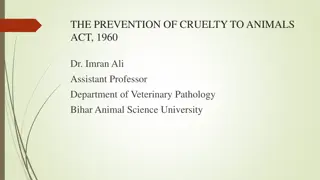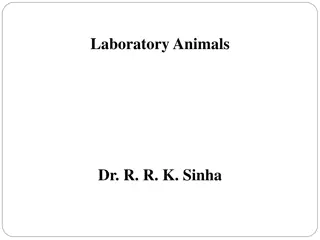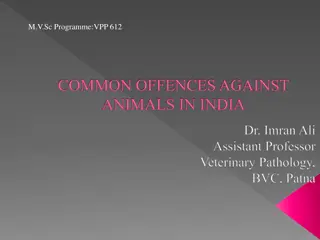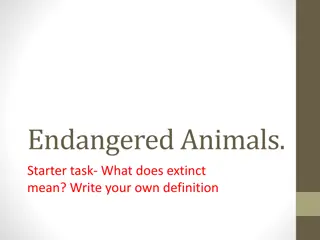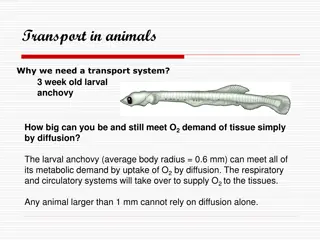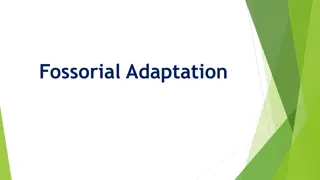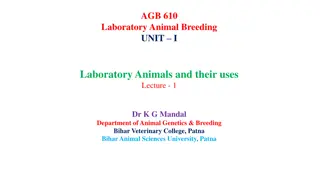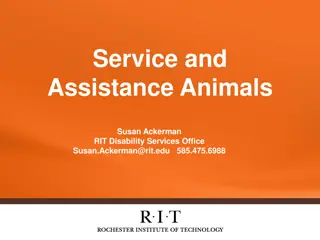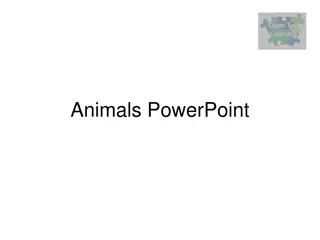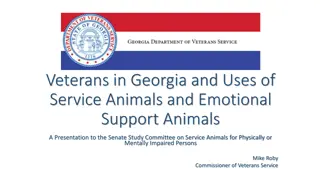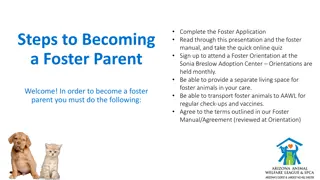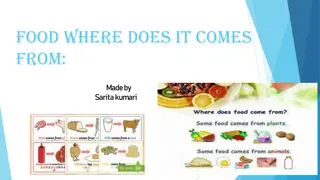Superstition in Animals
Behavior studies by Skinner and his students on animal superstition, operant conditioning, and response shaping, covering experiments with pigeons and insights into the basis of superstitious conditioning in animals and humans.
Download Presentation

Please find below an Image/Link to download the presentation.
The content on the website is provided AS IS for your information and personal use only. It may not be sold, licensed, or shared on other websites without obtaining consent from the author.If you encounter any issues during the download, it is possible that the publisher has removed the file from their server.
You are allowed to download the files provided on this website for personal or commercial use, subject to the condition that they are used lawfully. All files are the property of their respective owners.
The content on the website is provided AS IS for your information and personal use only. It may not be sold, licensed, or shared on other websites without obtaining consent from the author.
E N D
Presentation Transcript
Superstition in Animals Skinner: shaping and superstition First experiment Paired food with cue light Notice got autoshaping Noted several characteristics of behavior Always spun around Response was fixed and stereotyped Sequence to pigeon Superstition occurs in humans and other animals as well http://www.youtube.com/watch?v=X6zS7v9nSpo&feature=related
Interval between response and reward changed topography Know that short interval between keypecking and reward worked best Fewer intervening responses Effective interval depends On rate of conditioning and Rate of extinction Noted change in topography of response: Sharp movement of head from middle position to left More energetic Whole body turn Hopping step in front of wall Became fixed and rigid in its form
Interpretation: Superstition Animal accidentally paired inadvertent responses with reward This became basis of superstitious conditioning Extended to humans
Wolin: Again, a Skinner student Looked at pecking pigeons Used food rewards versus Water rewards
Water pecks vs. food pecks Discovered pecking was different between the two: Food peck: Rapid, powerful thrusts of head with beak OPEN Head bounces off key Water peck: Slower extension of head Beak almost closed Remains immersed in water Drinking = pumping action of tongue Scooping motion of beak
Changes in form of response Pecking rate varied depending on terminal event Food pecks faster Water pecks slower One of first to suggest that terminal event may guide operant response
Breland and Breland Marion and Keller Breland Skinner students Animal trainers Misbehavior of Organisms, 1961
One of first to contradict/disagree with Skinner publically Suggested that operant behavior not WHOLE explanation for emerging behavior Still strong behaviorists But also are ETHOLOGISTS Birst report: 1951 in American Psychologist
Instinctive drift The TENDENCY for a learned behavior (for trainers, that means a trained behavior) to trigger innate behaviors. The more similarity (topography) between the learned behavior and an innate behavior, the more likely the occurrence of the underlying innate behavior. The innate behavior, such as the dog's shaking its head to kill prey, may not come out full-blown at first, Gradually become stronger and stronger and more clearly defined with time and repetitions. With some animals and some behaviors, instinctive behavior can become strong enough to interfere with learned behavior.
Characterized several instances of animal misbehavior Sammy the Dancing Chicken The Miserly raccoon Prize releasing chickens Baseball playing chicken Piggy Bank Pig hamsters sea mammal
Why? Instincts "drift" into operant contingency Instinctive behavior drifting into R-Sr relationship and disrupting operant response Note that this delays reward Law of least effort Hebb: first to discuss neural networks: suggested prewiring Animals do not come to conditioning situation tabula rasa!
Re-examine pigeon behavior: pigeon in a box: http://www.youtube.com/watch?v=TtfQlkGwE 2U Pigeon mating behavior http://www.youtube.com/watch?v=kf1_hf00 ZzE Pigeon juvenile behavior http://www.youtube.com/watch?v=pnxTgjwE 1d4
Staddon and Simmelhag 1971 Re-examines Skinner s superstition experiment Examine relationship between evolution and learning Is ANY behavior learned, or are there boundaries of learning Two kinds of questions about Skinner s superstition experiment: Experiments with time-related reinforcement schedules have shown mediating behaviors during waiting period Time filling or adjunctive behaviors More so on FI thanVI schedules Some behaviors in operant situation appear to be elicited by PAvlovian conditioning, and not just by operant conditioning These appear to be biologically relevant behaviors Can even interfere with ongoing operants, a la Brelands
The Experiment 6 pigeons in standard operant box Three schedules of food delivery: FI 12: response independent VI 8 : response independent FI 12: Response DEPENDENT Habituation sessions: 10-min no food delivery in box Conducted response independent training: FI then VI VI then FI Response dependent training Two of birds trained on response-independent trained on response dependent Two na ve birds added
Scoring Used several behavior categories: Discrete or continuous responses Discrete: wall peck, key peck, floor peck, circles Continuous: flapping wings, window wall, move mag wall, preening, beak to ceiling, head in magazine, dizzy, head to magazine, locomotion
Results Two kinds of behavior: Terminal responses: those occurring 6-8 sec before Sr Interim activities: in between responses Terminal behaviors: Pecking Dizzy motion Pecking to WALL Interim behaviors: Early: pecking floor Circles Flapping wings Moving along wall Beak to ceiling
Strong Temporal pattern Pattern of behavior different depending on whether response de pendent or independent More pecking for response dependent Air pecks for response INDEPENDENT Pattern less stereotyped and rigid for VI schedules Several important characteristics: Strong sequential structure Each bird only showed small number of typical sequences Sequence within a bird VERY rigid Variability of sequences highest early on Not just due to random selection Acquisition phase and sequence Strong terminal and interim behaviors: formed two separate and distinct categories of behavior
Characteristics of responses Terminal response: Consummatory response More likely immediately following food Probability of terminal response increases with increasing probability of food delivery Interim responses: Adjunctive in nature Next to or as a time filler Occur at times when Sr is unlikely Not abnormalities- but seem to occur for a reason Why particular terminal behaviors: pavlovian conditioning? Biological boundaries?
Proposed a Theory to Explain: Interaction of evolution and learning Law of effect = acquisition model Doesn t specify WHAT behaviors, just how acquired May be prewired to display terminal and inte rim responses Situation selects particular terminal responses Interim responses are related to situation and are time fillers
Three important Factors The behavior in a situation before occurrence of reinforcement reflects many factors Past experience Motivation Species Setting conditions Transition from initial to final response is prob ably a function of natural selection/biology Darwinian selection principal like principles of reinforcement: Optimal behaviors are selected
Three important Factors Distinguishes between reinforcement and pr inciples of reinforcement: E.g. adaptation and process of selection by whi ch adaptation comes about Reinforcement specific situation Principles of reinforcement general guidelines
Several Factors for Selection of Responses Transfer processes (memory) Stimulus substitution Preparatory responses Syntactic constraints Orienting responses
Concludes: Reinforcement acts only on terminal response Reinforcement acts only to eliminate behaviors that are less directly correlated with reinforcement than others (NOT a stamping in effect) Superstition: response contingency imposed by most reinforcement schedules is not essential for the production of some terminal response, but only for selection of one terminal response over others (directs a response) Related responses also occur Acquisition is process by which select terminal responses Extinction is process by which terminal responses are unselected Notes: same is true for classical conditioning
Timberlake and Lucas, Pigeons in standard pigeon box Feeder on wall Feeder in floor Autoshaped to feeders 20 days to FT 15 schedule Examined behaviors Pecks to: hopper, floor, wall, wall directed Bob at wall; high bob at wall; low bob Walk, turn, crouch Wall hug Scraw wall Stay away from hopper Head in hopper Bob at wall hopper; bob at floor hopper; squat over floor hopper Flap wings, tail flick, groom No movement
Experiment 1 FT 15 sec with 5-s hopper all birds showed nearly identical behavior in two broad categories circling away from hopper repetitive hopper movements Identical topographies make it unlikely is accidental conditioning Different topographies than found by Staddon and Simmelhag still had terminal and interim behaviors no key pecking! Note: were na ve birds
Experiment 2 4 na ve birds Assigned to peck or no peck (turn) conditions and hopper trained FI 15 or FT 15 schedules Those birds trained to initially turn rather than peck showed greater variety of locomotor behavior and more stand-away form of wall directed behavior
Experiment 3 Used birds from experiment 1 FT 15, ext then FT15 Extinction behavior = single, motionless position for entire session When food reintroduced: rapidly resumed prior responses
Experiments 4 and 5 Made food contingent on wall behavior, or used an omission training procedure (NO wall = reinforcement) again FT 15, FD3 sec, FT15 with contingency (CP), FT 15 Saw typical wall oriented behaviors again With contingency: wall- oriented behaviors occurred sooner; shortened walk away pattern Omission contingency unsuccessful: continued to do some wall behaviors despite omission continency- although away behaviors increased
Intermediate Conclusions Neither model is correct Isn t accidental Isn t really stimulus substitution, either Omission procedure shows pigeons really couldn t stop wall behaviors- had to find another way to express these or kept doing them
More Experiments Experiments 6 a and 6b: Shortened hopper time to 2 sec from 5 sec Used na ve and experienced birds Found wall hugging and locomotor (interim) Short hopper didn t increase pecking responses Experiment 7: Examined strain differences Used white carneaux, silver king and white king pigeons No real differences
And MORE Experiments Experiment 8: hole in floor 4 na ve pigeons Floor feeder vs wall feeder Results: Got floor pecking! Low bobs, lower behaviors More locomotor behavior Form of behavior changed with change in loca Final experiment 9: Suggests that ecologically relevant stimuli elicit ecologically relevant behaviors....appetitive structure behaviors 4 na ve pigeons Funnel shaped feeder in floor at wall- food tray Behaviors elicited: Circling, head oriented toward floor, stepping and bobbing
Conclusions Common set of responses: Wall-directed when feeder on wall Floor directed when feeder on floor Head, neck movements Circling Behaviors are supported by periodic presentation of food Superstitious behaviors come from species evolved system selected to produce species typical appetitive behavior patterns in presence of food (and other stimuli!) Pecking occurs when pecking is appropriate Interim behavior = post-food behaviors nonconsummatory
Behavior Systems Theory Organization of behavior depends on functional systems related to ecological variables Organized in units or modules of behavior Appetitive/consummatory responses Search Capture Preparatory handling Ingestion
So: what are superstitious behaviors Behaviors resulting from a set of motivational modes Modes appear to consist of repertoires of perceptual-motor organization involving stimulus sensitivities and related response components Organization arises both from innate and learned sources in combination with particular environmental circumstances in effect Four basic modes are seen: General search Focal search Handle/consummatory mode Postfood focal search


